COMMENT OF THE DAY: CURRENT HOUSTON AIR SMELL RATINGS, MINUS THE COFFEE PERFUME  “It seems like it’s getting worse. 4 out of 7 mornings when it used to be maybe 2 out of 7. I wonder if it’s because the east downtown coffee plant has been shutdown, no longer masking the more harsher notes.” [Jeff, commenting on The Houston Hurricane Pollution-Sniffing NASA Flight That Never Took Off] Illustration: Lulu
“It seems like it’s getting worse. 4 out of 7 mornings when it used to be maybe 2 out of 7. I wonder if it’s because the east downtown coffee plant has been shutdown, no longer masking the more harsher notes.” [Jeff, commenting on The Houston Hurricane Pollution-Sniffing NASA Flight That Never Took Off] Illustration: Lulu
Tag: Pollution
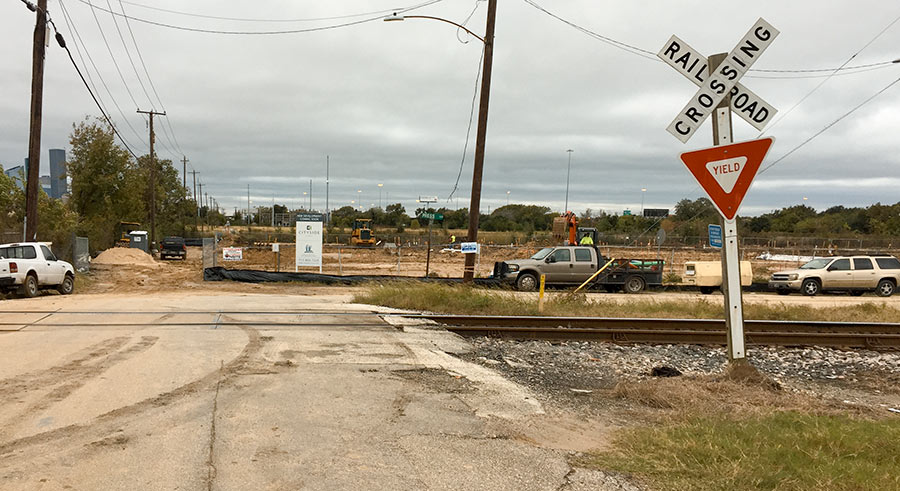
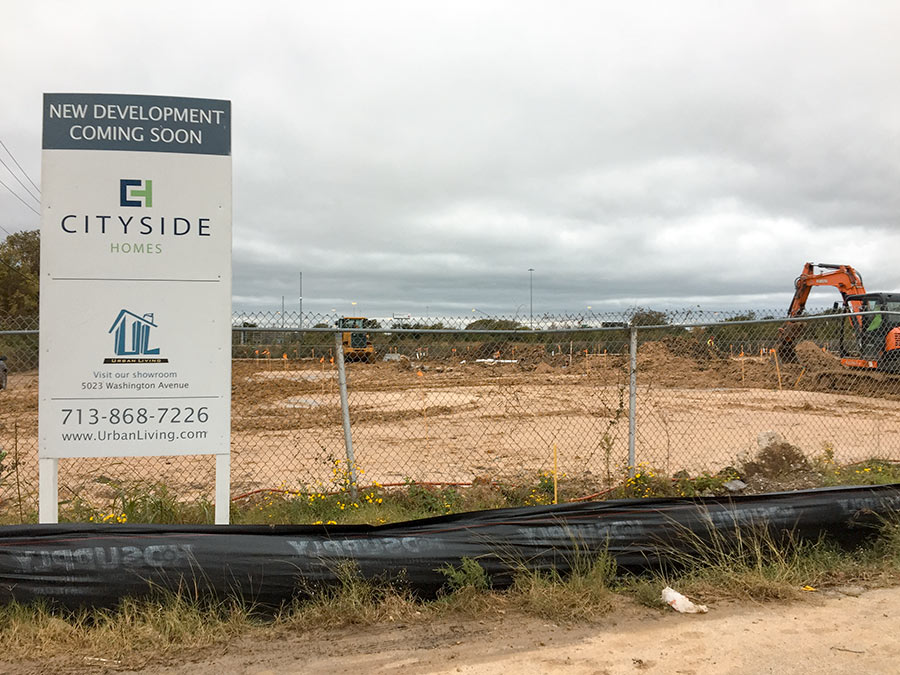
Aside from the presence of workers, the only hint you’ll find that construction has begun on the MDI Superfund site is the sign now standing at the location itself (and the HAIF thread where a user first called attention the whole scene). It’s facing toward the end of Gillespie St., a tiny Fifth Ward road that crosses over Hirsch Rd. and some railroad tracks 3 blocks north of Clinton Dr. before petering out into the eastern edge of the vacant, 35-acre industrial site. There, 3 acres are now giving rise to 42 new townhomes put there Urban Living, the Houston developer that received a multi-million dollar bill in court last week for copying copyrighted townhome plans at a handful of other sites. It’s calling this latest batch East River Yards (an apparent nod to the other industrial tract just south, the gradually crumbling KBR campus that’s been redubbed East River.)
The East River Yards houses will cluster around 3 shared driveways, all of which let out onto Press St.:
COMMENT OF THE DAY: THE REAL REASON WHY BUFFALO BAYOU SMELLS AND LOOKS THE WAY IT DOES 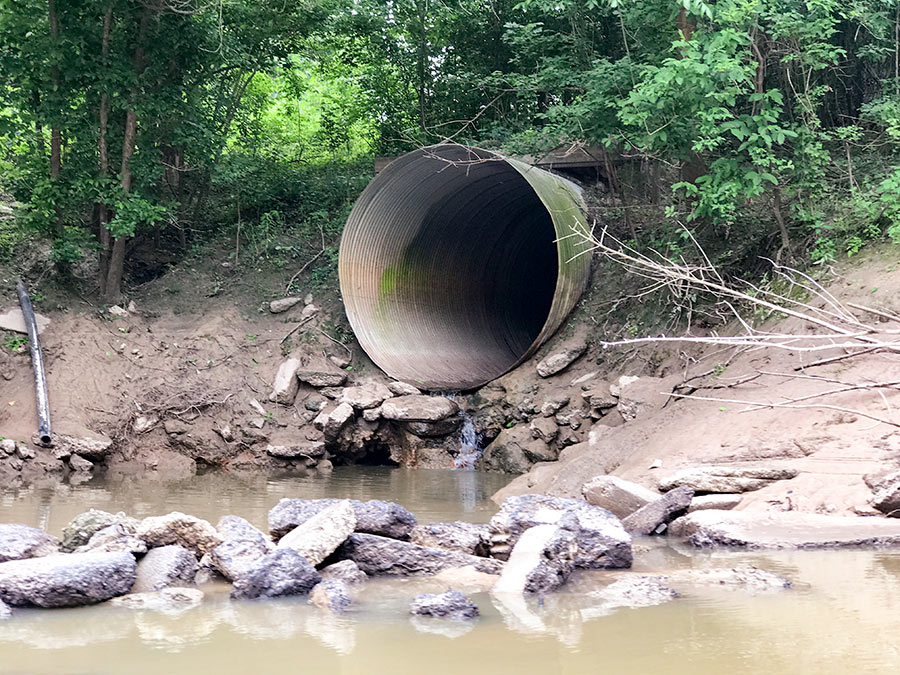 “If Buffalo Bayou stunk so much, then no one would have built a bunch of expensive homes all along it (west of downtown). Most of the Houston area’s waste water effluent flows into the Bayou east of downtown anyways. The Clinton/69th plant (the largest in the city) is just east of downtown, and the Sims and Braes plants don’t enter until well past downtown. With that said, I don’t think the treatment plants are the big contributors to the overall unpleasantness of the Buffalo Bayou water (flood events not withstanding). Most of the effluent (when the plants are properly operating) is nearly clear and usually only has an ‘earthy’ odor to it if any at all. I think the big issue with the bayou’s water quality is the regular runoff and trash that flows into it and eventually lines the shores of it all along downtown.” [nmj, commenting on The North Canal, a New Downtown Island, and Other Secret Plans for Downtown Houston’s Future] Photo: Swamplot inbox
“If Buffalo Bayou stunk so much, then no one would have built a bunch of expensive homes all along it (west of downtown). Most of the Houston area’s waste water effluent flows into the Bayou east of downtown anyways. The Clinton/69th plant (the largest in the city) is just east of downtown, and the Sims and Braes plants don’t enter until well past downtown. With that said, I don’t think the treatment plants are the big contributors to the overall unpleasantness of the Buffalo Bayou water (flood events not withstanding). Most of the effluent (when the plants are properly operating) is nearly clear and usually only has an ‘earthy’ odor to it if any at all. I think the big issue with the bayou’s water quality is the regular runoff and trash that flows into it and eventually lines the shores of it all along downtown.” [nmj, commenting on The North Canal, a New Downtown Island, and Other Secret Plans for Downtown Houston’s Future] Photo: Swamplot inbox
COMMENT OF THE DAY SECOND RUNNER-UP: THINGS TO THINK ABOUT BEFORE YOU START PLANNING UNDER-FREEWAY DEVELOPMENTS  “One conclusion I’ve made about the U.S., compared to European countries, is that we don’t use space efficiently. We’ve got all these open ditches, grass patches . . . along our roadways. So this Tokyo solution appeals to me.
But while I haven’t traveled extensively, I feel that selling/renting under-highway space to retail smacks of third-world. Would Houston ever go for that?
There is so much filth that washes off roadways and would filter into/onto these shops. A friend has his bike storage cage under the apartment driveway. It’s just a drive! yet the bikes always have a greasy blackness on them. Ever park in an airport garage for more than a couple days? Your car is filthy.
Maybe it’s just me, but I wouldn’t/couldn’t eat a taco made under the Pierce Elevated.” [movocelot, commenting on Midtown Sears Closure Nets Rice 9 Acres near the Wheeler Transit Center] Illustration: Lulu
“One conclusion I’ve made about the U.S., compared to European countries, is that we don’t use space efficiently. We’ve got all these open ditches, grass patches . . . along our roadways. So this Tokyo solution appeals to me.
But while I haven’t traveled extensively, I feel that selling/renting under-highway space to retail smacks of third-world. Would Houston ever go for that?
There is so much filth that washes off roadways and would filter into/onto these shops. A friend has his bike storage cage under the apartment driveway. It’s just a drive! yet the bikes always have a greasy blackness on them. Ever park in an airport garage for more than a couple days? Your car is filthy.
Maybe it’s just me, but I wouldn’t/couldn’t eat a taco made under the Pierce Elevated.” [movocelot, commenting on Midtown Sears Closure Nets Rice 9 Acres near the Wheeler Transit Center] Illustration: Lulu
EPA: YEAH, BETTER CLEAN OUT THE DIOXIN PITS FROM THE SAN JACINTO RIVER NOW THAT THEY’VE LEAKED A bit later than had been urged by those alarmed by the longterm presence of pits full of toxic waste sealed only with a tarp on top hanging out in the San Jacinto River, the EPA has now approved a plan to remove most of the dioxin stored within them. “As exemplified today, EPA is prioritizing Superfund clean-up by making decisions in a decisive, timely manner,” reads a statement from administrator Scott Pruitt released this afternoon. “The San Jacinto Waste Pits site was added to the National Priority List nearly a decade ago.” What’s the rush? As predicted by EPA studies and many a casual observer, the pits appeared to have leaked extensively after Hurricane Harvey flooding. Under the new $115 million plan, cofferdams will be installed around the pits and almost 212,000 cubic yards of dioxin-contaminated material will be excavated — leaving just enough behind that the agency can, it says, ensure controls that will “prevent access, eliminate off-site migration, and monitor the natural recovery into the future.” [EPA; more info; Houston Chronicle; previously on Swamplot] Video of waste pits after Harvey flooding: Greg Moss
Captured on Sunday between bands of Harvey downpour by an enterprising drone photographer hunkering in Friendswood, the video above includes a quick pan over the Brio Superfund site south of Beamer Rd. near the intersection with Dixie Farm Rd. The former chemical facility, once at the heart of both the long-gone Southbend neighborhood and of the series of lawsuits filed by Southbend residents over contamination-related birth defects and illnesses, makes its cameo around minute 3, as the drone passes over a waterlogged Exxon Mobil station and rotates from south to east down Beamer toward the San Jacinto College South Campus.
Might floodwaters flowing across the Brio site and all those other Superfund spots dotting the local map have stirred up toxin-laced sediments and spread them around? (Texas A&M Galveston scientist Wes Highfield was worried enough about the possibility to attempt a mid-flood outing from his home to try to get some water samples.) In the video, the Brio site appears to be a little less waterlogged than some of its surroundings — including the adjacent section of Beamer Rd., shown picking up a bit of kayak traffic — but likely got washed over by around 42 in. of rain altogether in the past week.
In a follow-up drone run flown on Wednesday, the site (making an appearance about 2-and-a-half minutes in) looks like it might have dried off a bit:
SMELLING BLIND IN THE EAST END 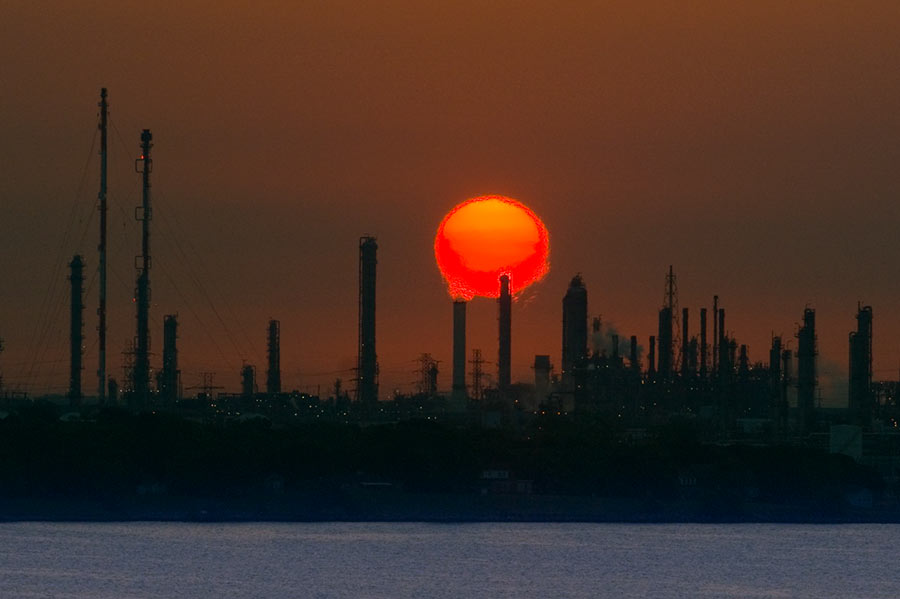 A possible cause of the nasty smells that caused East End residents headaches, sore and scratchy throats, and itchy eyes as Hurricane Harvey approached and inundated the area? Houston-area industrial plants in the last week released more than 2.25 million pounds of emissions above legal limits, according to an Environment Texas tally of Texas Commission on Environmental Quality data. The reason: plant shutdowns before the onset of the storm and startups after it left. “So far,” writes Emily Atkin, “TCEQ has not indicated these events have triggered health impacts. . . . TCEQ Media Relations Manager Andrea Miller told me the agency or local emergency officials would contact residents if an immediate health threat were to occur. What’s more, Miller said companies were probably reporting higher emissions that what actually occurred, ‘since underreporting can result in higher penalties.‘ It’s unclear, however, how TCEQ would check many of the companies’ reports, since the agency turned off all its air quality monitors in the Houston area before Harvey hit. Miller confirmed as much on Monday, saying devices were either turned off or removed “to protect against damage or loss of these sensitive and expensive instruments.†[The New Republic] Photo of ExxonMobil Baytown refinery: Louis Vest [license]
A possible cause of the nasty smells that caused East End residents headaches, sore and scratchy throats, and itchy eyes as Hurricane Harvey approached and inundated the area? Houston-area industrial plants in the last week released more than 2.25 million pounds of emissions above legal limits, according to an Environment Texas tally of Texas Commission on Environmental Quality data. The reason: plant shutdowns before the onset of the storm and startups after it left. “So far,” writes Emily Atkin, “TCEQ has not indicated these events have triggered health impacts. . . . TCEQ Media Relations Manager Andrea Miller told me the agency or local emergency officials would contact residents if an immediate health threat were to occur. What’s more, Miller said companies were probably reporting higher emissions that what actually occurred, ‘since underreporting can result in higher penalties.‘ It’s unclear, however, how TCEQ would check many of the companies’ reports, since the agency turned off all its air quality monitors in the Houston area before Harvey hit. Miller confirmed as much on Monday, saying devices were either turned off or removed “to protect against damage or loss of these sensitive and expensive instruments.†[The New Republic] Photo of ExxonMobil Baytown refinery: Louis Vest [license]
COMMENT OF THE DAY: MIGHT UPSET HOUSTON’S DELICATE WATERWAY ECOSYSTEM 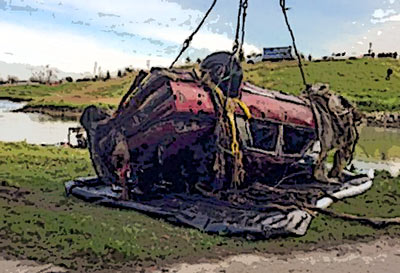 “. . . I suppose all those cars need to come out of the bayou, but I fear that will really mess up the fishing.” [Txcon, commenting on Comment of the Day: Aside from These 2 Issues, Fishing in Brays Bayou Is Enormously Appealing]
“. . . I suppose all those cars need to come out of the bayou, but I fear that will really mess up the fishing.” [Txcon, commenting on Comment of the Day: Aside from These 2 Issues, Fishing in Brays Bayou Is Enormously Appealing]
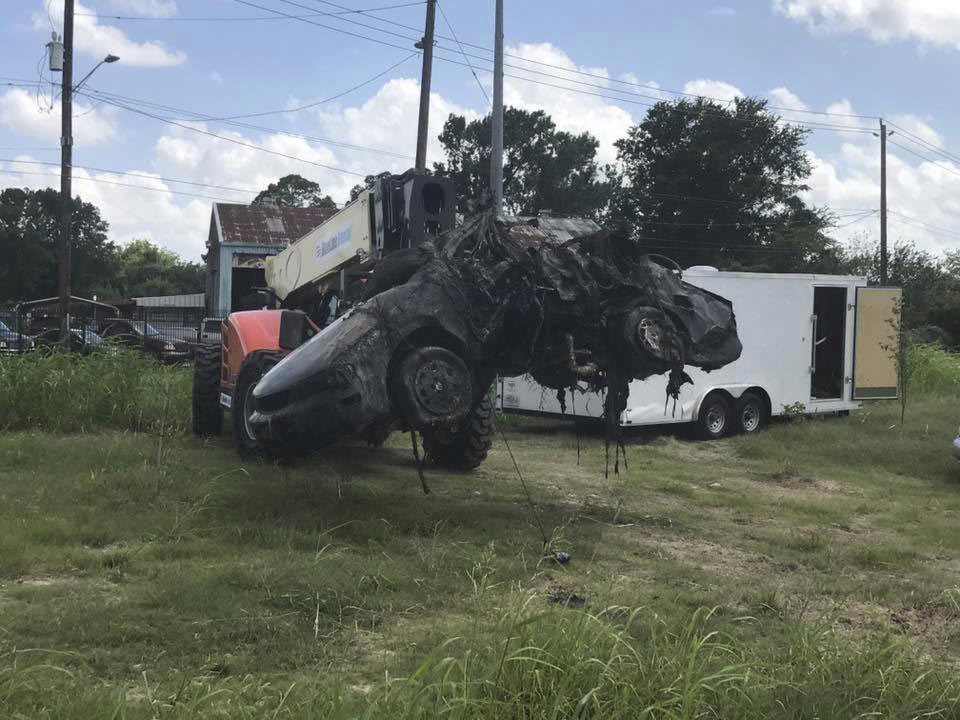
A stolen Dodge Durango was the first car pulled out of Brays Bayou earlier this month as Harris County Flood Control and friends resumed work on removing some of the 100-plus sunken vehicles previously discovered gently rusting below the surface of a few of Houston’s major waterways. (The Nissan Maxima above was next in line.) Last year’s test run of the removal setup snagged a total of 20 cars out of Brays and Sims bayous; the contracts signed earlier this year for a new round of vehicle fishing budget for a catch of around 65 vehicles from the 2 bayous, depending on size and how much of a fight each one puts up. (Texas Equusearch did note back in its 2011 survey that at least one big rig is lurking somewhere in the watery depths, and some of the cars are more filled with mud and debris than others.)
The county says the new car count was up to 13 by the time work crews paused last week to let Cindy pass; a county worker also snapped photos showing off some of the haul, which has so far included a range of more and less easily identifiable makes and models including a Nissan Frontier, a Jaguar, a Ford Mustang, a Ford Bronco, an Eagle Talon, and others:
COMING OFF THE STATE WATCHLIST DOESN’T MEAN HOUSTON’S POLLUTION HOTSPOTS DON’T STILL NEED TO BE WATCHED 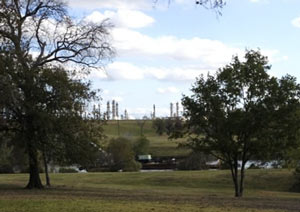 Of the 14 sites pulled off the Texas Commission for Environmental Quality’s special pollution watchlist since 2007, Elena Craft writes in the Chronicle’s Gray Matters column today, some 8 of them have since had new noteworthy upticks of various chemicals linked to health issues like breathing problems, nerve problems, or cancer, according to the Environmental Defense Fund’s recent study. Craft dives into some of the sticky aspects of trying to keep track of whether chemical levels are above normal for visitors and residents near spots like Milby Park (above) and the Lynchburg Ferry area, including the fact that the data collected by on-site monitors isn’t always available to the public right away, and that short-term high levels of problem chemicals don’t usually get investigated. “The absence of information about these seemingly random pollution spikes is troubling,” Craft writes, “because it suggests that TCEQ has stopped paying attention before its work is truly complete.” [Houston Chronicle; previously on Swamplot] Photo of Milby Park: Ric F.
Of the 14 sites pulled off the Texas Commission for Environmental Quality’s special pollution watchlist since 2007, Elena Craft writes in the Chronicle’s Gray Matters column today, some 8 of them have since had new noteworthy upticks of various chemicals linked to health issues like breathing problems, nerve problems, or cancer, according to the Environmental Defense Fund’s recent study. Craft dives into some of the sticky aspects of trying to keep track of whether chemical levels are above normal for visitors and residents near spots like Milby Park (above) and the Lynchburg Ferry area, including the fact that the data collected by on-site monitors isn’t always available to the public right away, and that short-term high levels of problem chemicals don’t usually get investigated. “The absence of information about these seemingly random pollution spikes is troubling,” Craft writes, “because it suggests that TCEQ has stopped paying attention before its work is truly complete.” [Houston Chronicle; previously on Swamplot] Photo of Milby Park: Ric F.
HARRIS COUNTY GETTING IN ON THE PASADENA REFINERY AIR POLLUTION LAWSUIT ACTION 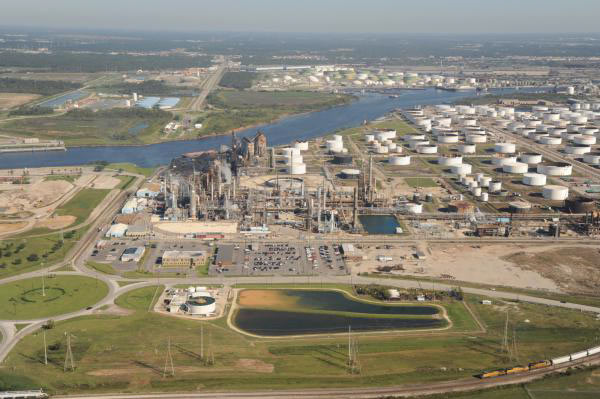 In the wake of the lawsuit the Sierra Club and Environment Texas filed last week alleging that the century-old Pasadena Refining System plant has violated the federal Clean Air Act some thousands of times, Harris County attorney Vince Ryan has filed another suit against the plant.  This one’s to do with the facility allegedly breaking state level environmental laws, Diana Wray writes in this week’s Houston Press; incidents of particular note include last summer’s major sulfur dioxide leak, which briefly shut down both the nearby Washburn Tunnel and the rest of the Ship Channel (while sending Galena Park into duck-and-cover mode). Wray writes that both lawsuits seem mostly geared toward getting the plant to clean up its act; each suit also has the potential to require that some kind of compliance watchdog or overseer be assigned to plant to ensure that it’s doing so. [Houston Press; previously on Swamplot] Photo of Pasadena Refinery Systems, Inc. plant at 111 Red Bluff Rd.: Center for Land Use Interpretation (license)
In the wake of the lawsuit the Sierra Club and Environment Texas filed last week alleging that the century-old Pasadena Refining System plant has violated the federal Clean Air Act some thousands of times, Harris County attorney Vince Ryan has filed another suit against the plant.  This one’s to do with the facility allegedly breaking state level environmental laws, Diana Wray writes in this week’s Houston Press; incidents of particular note include last summer’s major sulfur dioxide leak, which briefly shut down both the nearby Washburn Tunnel and the rest of the Ship Channel (while sending Galena Park into duck-and-cover mode). Wray writes that both lawsuits seem mostly geared toward getting the plant to clean up its act; each suit also has the potential to require that some kind of compliance watchdog or overseer be assigned to plant to ensure that it’s doing so. [Houston Press; previously on Swamplot] Photo of Pasadena Refinery Systems, Inc. plant at 111 Red Bluff Rd.: Center for Land Use Interpretation (license)
UNIDENTIFIED CHEMICAL STENCH, HAZE DRIFTING ACROSS TOWN OFFICIALLY NO CAUSE FOR CONCERN 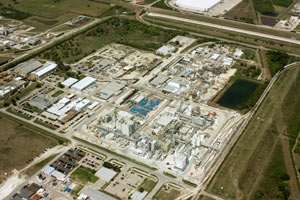 Suggested and mandatory restrictions on hanging around outside were issued by the Memorial Village area’s fire department and by Katy ISD respectively for a while this morning, in response to the acrid odor and haze blowing in some 40 miles across the city from somewhere near the Ship Channel. The Houston emergency response folks say that their monitoring has turned up no air quality red flags, but that anyone who can avoid the stink should probably do so just in case. The particular origin and composition of the odor also still seems to still be up for debate this afternoon: The Albemarle facility at 13000 Bay Park Rd. (shown above) called into the CAER hotline this morning to report that they might be releasing natural gas odorizer throughout the day as their gas facilities got worked on, and LyondellBasell’s Sheldon Rd. facility also sent a message to the CAER line that they would be conducting flaring today in response to a “unit upset,” but no official suspects have been named by the city. The extent of the odor’s inland spread is notably broader than last month’s quickie Valero tank overfill stench incident in Manchester: KHOU reports that some of its viewers on the southeast side of town started calling in about the smell around 10 am, and that “by 11 a.m. the smell and an apparent haze covered most of downtown Houston and the west side, with some reports from as far north as Bush Airport.” [KHOU; previously on Swamplot] Photo of Albemarle facility at 13000 Bay Park Rd.: April R.
Suggested and mandatory restrictions on hanging around outside were issued by the Memorial Village area’s fire department and by Katy ISD respectively for a while this morning, in response to the acrid odor and haze blowing in some 40 miles across the city from somewhere near the Ship Channel. The Houston emergency response folks say that their monitoring has turned up no air quality red flags, but that anyone who can avoid the stink should probably do so just in case. The particular origin and composition of the odor also still seems to still be up for debate this afternoon: The Albemarle facility at 13000 Bay Park Rd. (shown above) called into the CAER hotline this morning to report that they might be releasing natural gas odorizer throughout the day as their gas facilities got worked on, and LyondellBasell’s Sheldon Rd. facility also sent a message to the CAER line that they would be conducting flaring today in response to a “unit upset,” but no official suspects have been named by the city. The extent of the odor’s inland spread is notably broader than last month’s quickie Valero tank overfill stench incident in Manchester: KHOU reports that some of its viewers on the southeast side of town started calling in about the smell around 10 am, and that “by 11 a.m. the smell and an apparent haze covered most of downtown Houston and the west side, with some reports from as far north as Bush Airport.” [KHOU; previously on Swamplot] Photo of Albemarle facility at 13000 Bay Park Rd.: April R.
Urban wildlife cellphone videographer Christine Wilson sends some footage captured from Allen’s Landing documenting the eons-old nature vs. civilization struggle, which played out earlier this week in the form of tiny ducks dodging their way through the floating trash field where White Oak and Buffalo bayous join up. Wilson caught sight (and sound) of a duck and 4 ducklings struggling across the White Oak outflow toward the Buffalo side of the confluence, which she notes is significantly less debris-spangled. That’s the Harris County Jail in the background for most of the shot, across White Oak from the main building of the University of Houston Downtown. (The footage cuts out mid-scene, but Wilson says the ducks did eventually make it across.)
Video: Christine Wilson
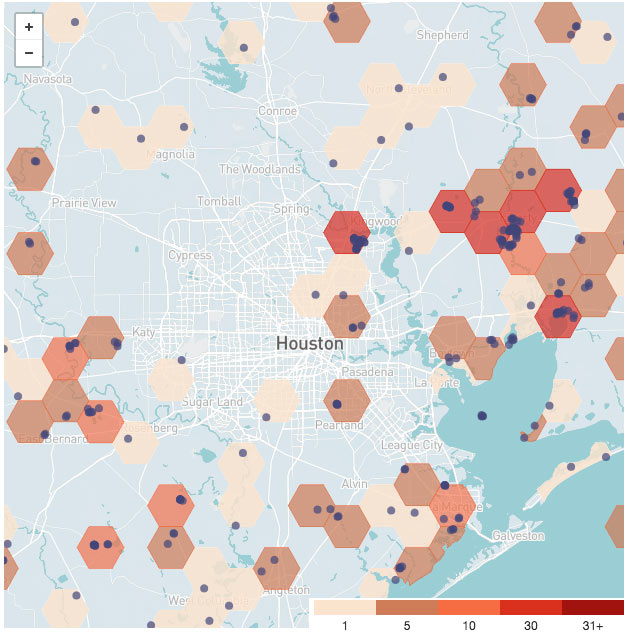
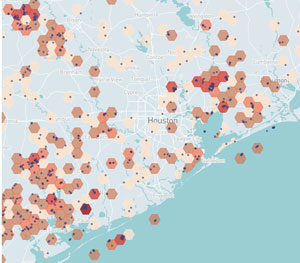 The map above (a snap from Luke Whyte’s click-and-zoom-able original version, published this week by the Texas Tribune) shows the abandoned oil and gas wells scattered in and around the Houston area, per the official accounting of the Texas Railroad Commission. The state agency (which has had nothing to do with railroads since 2005) regulates pipelines, oil, and gas, and keeps tabs on so-called “orphaned wells” whose original owners have stopped keeping tabs on them for one reason or another, writes Jim Malewitz this week — the ones that were reported in the first place, that is. Kerry Knorpp, formerly on a defunct state committee overseeing oilfield cleanup efforts, also tells Malewitz that “there is about to be a tsunami of [newly] abandoned wells — wells were drilled at $110 oil that you would have never completed otherwise.â€
The map above (a snap from Luke Whyte’s click-and-zoom-able original version, published this week by the Texas Tribune) shows the abandoned oil and gas wells scattered in and around the Houston area, per the official accounting of the Texas Railroad Commission. The state agency (which has had nothing to do with railroads since 2005) regulates pipelines, oil, and gas, and keeps tabs on so-called “orphaned wells” whose original owners have stopped keeping tabs on them for one reason or another, writes Jim Malewitz this week — the ones that were reported in the first place, that is. Kerry Knorpp, formerly on a defunct state committee overseeing oilfield cleanup efforts, also tells Malewitz that “there is about to be a tsunami of [newly] abandoned wells — wells were drilled at $110 oil that you would have never completed otherwise.â€
The shaded hexagons above are meant to help show the density of those holes, not the degree to which they might pose a pollution hazard (though the agency ranks each well by its hazard potential, too, to help it decide which ones to plug up first, of the more than 10,000 currently on the docket).
Just what kind of hazards can a bunch of abandoned holes pose, anyway?
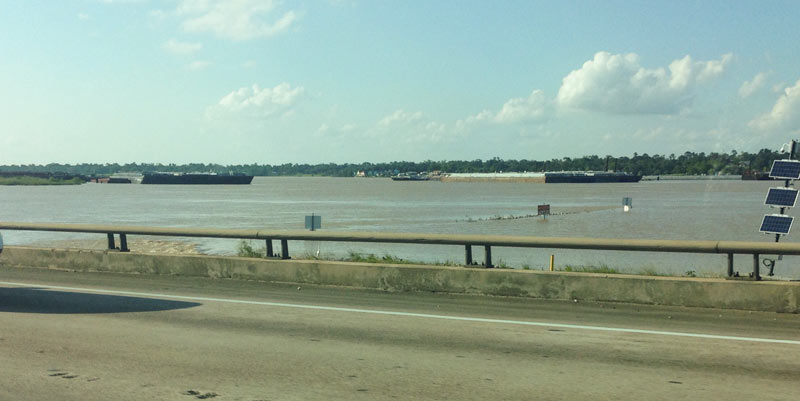
Weather permitting, an area along the edge of the San Jacinto Waste Pits Superfund site under the I-10 East bridge should be getting around 800 cubic feet of new rocks piled onto it this week and next, according to this month’s EPA update on the project. The agency asked International Paper and McGinnis (which might be on the hook financially for much of the final cleanup) to cover up some recently-discovered areas of the nearby riverbed that were scoured as deep as 8 feet in some places by this spring‘s torrential flooding; the tarp-with-rocks-on-it armored cap itself doesn’t appear to have been damaged, but the EPA says the extra rocks will help ensure its continued protectiveness.

